ECommerce sellers are always trying to convince consumers to buy something. In order to do this effectively, there are various psychological principles you can utilize to influence human behavior and decision-making. This study of consumer behavior and their response to various marketing tactics is known as marketing psychology.
We humans have a lot going on in our brains, so our subconscious minds build shortcuts to help us make decisions. We make many decisions emotionally and illogically, based on psychological principles of which we are not even aware. As an eCommerce seller, a basic understanding of these fundamentals can help you build marketing techniques that trigger emotional reactions, convincing consumers to behave a certain way.
Here are 10 psychological principles that eCommerce marketers can use to attract customers and increase conversions.
- Priming
- Loss Aversion
- Anchoring
- Choice Overload
- Reciprocity Principle
- Framing Effect
- The Decoy Effect
- The Mere Exposure Effect
- Scarcity Principle
- Bandwagon Effect
1. Priming
Priming is when a word or image presented to a person influences their response to a stimulus that follows. The person has no awareness that the connection is happening in their subconscious mind, either.
For example, if a person is exposed to the word “doctor”, they will then more quickly recognize the word “nurse” than an unrelated word, such as “telephone”. This is because words relating to the field of medicine are closely associated in their mind.
Priming can also influence behavior without the subject’s awareness. A 2018 study published in the journal Aging and Mental Health showed the effect of priming on a group of elderly participants. The subjects were given an article to read, either highlighting positive or negative messages about elderly people in society. They were then asked to memorize a set of 30 words. The participants who had read the positive article performed significantly better on the task than those who received negative messages.
Priming in marketing
Priming can be a powerful tool in marketing. In fact, it’s already working on you. What comes to mind when you see two big yellow arches while driving down the expressway? You immediately know there’s a McDonalds nearby, and are more likely to make a pit stop.
As an eCommerce seller, you can use priming to influence visitors to your website. Using this method, you can prime people to remember certain information and even influence their behavior. For example, you can prime people to pay special attention to the price of an item by showing them images and words associated with money.
Subscribe to the eCommerce newsletter for
top industry insights
Another way to use priming in marketing is with the Foot-in-the-Door method. This method primes people to say “yes” by starting out with small requests, and eventually getting to your big ask. Prompting consumers to sign up for a free newsletter, share a social media post, or listen to a podcast before asking them to make a purchase can prime them so that they are more likely to say yes later on.
2. Loss Aversion
Loss aversion is the tendency for people to feel more pain when losing something than pleasure from gaining the same thing. For example, losing $100 is more painful than gaining $100 is pleasurable. In other words, it’s more desirable not to lose those $100 than it is to find $100.
This is a powerful cognitive bias, and can greatly impact human behavior. A frequently cited 1979 study demonstrated that participants placed a higher value on an object that they already owned than they placed on the same item if they did not already own it. A more recent study conducted in 2019 showed that people tend to choose small, guaranteed rewards over bigger but more risky outcomes.
Loss aversion in marketing
Many marketers use loss aversion to convince people to buy products without even knowing it. For example, displaying a limited quantity of product available or offering a special price “while supplies last” are two common loss aversion tactics.
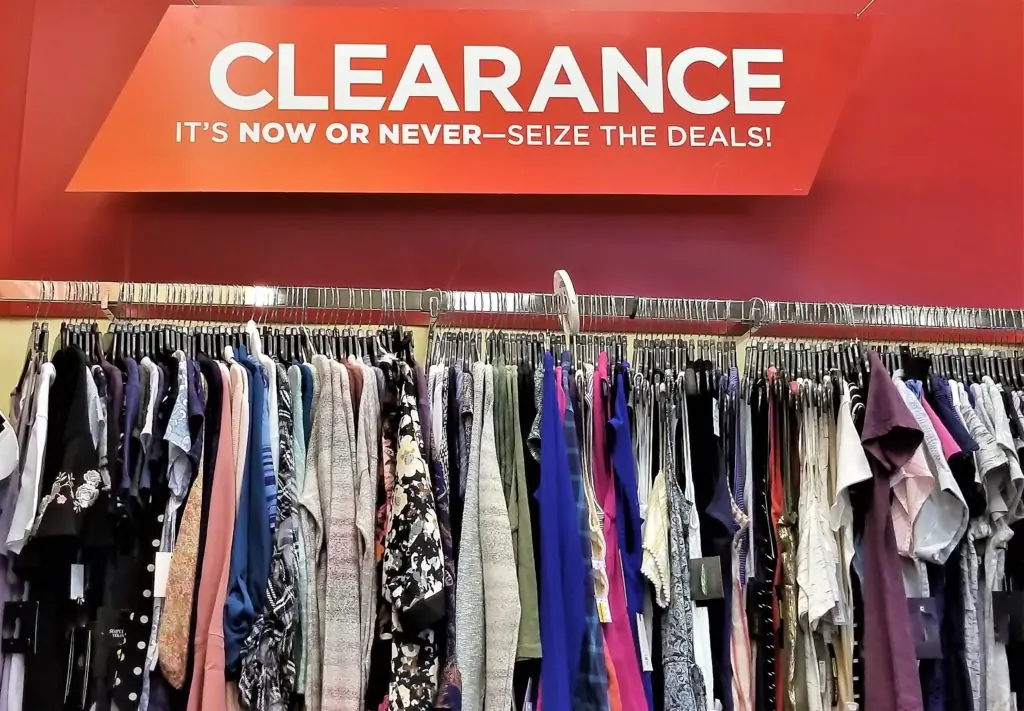
By creating a feeling of urgency and FOMO (fear of missing out), marketers play off of consumers’ base desire to avoid loss. This is a great way to persuade them to buy something now, instead of waiting until later, increasing the chances that they will actually go through with the purchase.
3. Anchoring
Anchoring is a natural cognitive shortcut that triggers people to regard the first piece of information they receive as an “anchor”, making future decisions using that as a baseline. This occurs entirely subconsciously, without any awareness that it is happening.
People will therefore tend to judge newer information compared to that initial anchor, altering their assessment of the situation. Anchoring is commonly seen in salary negotiations. Job candidates know to start off the negotiation asking for a higher salary than they might actually expect to receive. If the hiring manager sees that number as the anchor, it skews the final agreement toward a higher salary.
Anchoring in marketing
If you’ve ever gone shopping and seen a price crossed out and a new, lower price written underneath, you’ve come face to face with anchoring. This is an extremely common marketing tactic that is used everywhere from Amazon to supermarkets.
You might see a sweater that costs $40 and think that it’s too expensive for your budget. But if you see a sweater that typically costs $60 on sale for $40, you’re more likely to think that you’re getting a good deal. The anchoring effect tricks you into basing your decision off of the initial price of $60, making it seem like $40 is a steal.
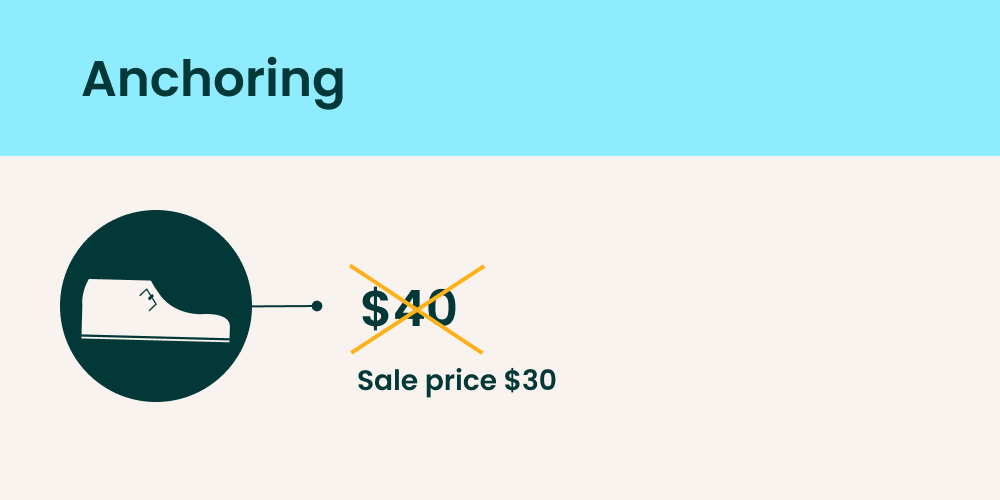
This is an easy technique to incorporate into your marketing strategy. If you’re running a sale, for example, simply display the regular price next to the new sale price. Consumers will see the older price as the anchor, making the sale price seem like an even better deal.
4. Choice Overload or the Paradox of Choice
When people are faced with too many options, they become overwhelmed and struggle to make a decision. This is known as choice overload or the paradox of choice. Imagine you’re at the grocery store and you want to buy bread. You find the bread aisle and are suddenly confronted with dozens of options. There’s white bread and whole wheat bread, multigrain bread and rye bread. You can buy whole loaves of bread or sliced bread, or perhaps you want rolls, bagels, or pita bread. Then you have to decide which brand to buy, too!
When there are too many choices, people are often so afraid of making the wrong decision that they’ll abandon the purchase altogether. And if they do buy something, they’re more likely to feel a sense of disappointment or regret about their decision.
In a famous study, researchers offered jam samples to customers in a market. They either offered 24 different jam samples or six different jam samples. When they offered 24 jams, 60% of customers stopped to taste them but only 3% bought a jar. When they offered six jams, fewer customers stopped to taste, but 30% of those people bought jam! While more choices did indeed attract more customers, it also made it harder for those customers to make the decision to buy.
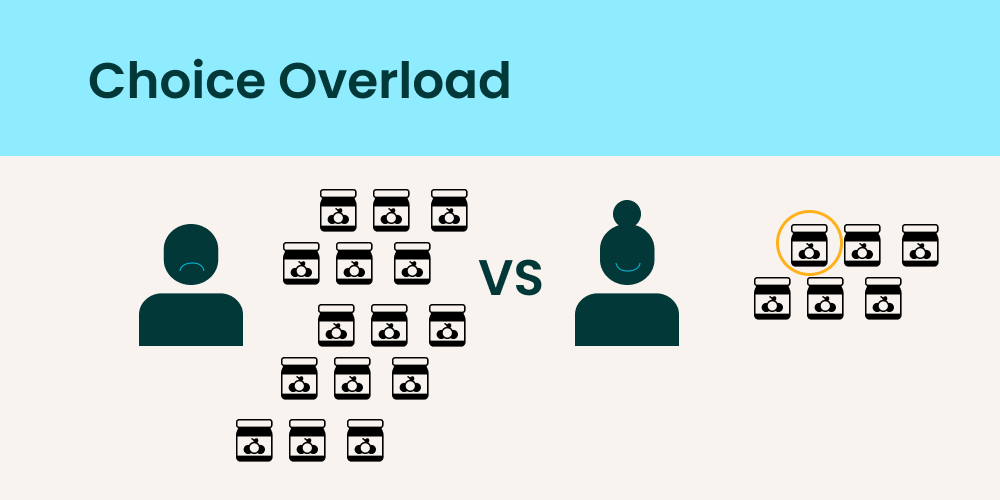
Choice overload in marketing
As a marketer, keeping the choice overload effect in mind is important. You want to offer customers enough variety so they feel that they have a choice, but not too many options or they will get overwhelmed.
It’s a good idea to give your customers just a few options when it comes to product color or price tier, for example. Keeping the navigation bar on your website minimal, with just a few options, is also important so visitors don’t get confused and click away.
Simplify decisions for your customers in order to eliminate confusion and avoid choice paralysis and lost sales.
5. Reciprocity Principle
People tend to feel a sense of obligation to give back to others when they give something to us. It’s drilled into us from a young age. If someone says “hi” to you while walking down the street, you feel compelled to return the greeting, even if you don’t know the person.
This is known as the reciprocity principle. If you do something kind for someone, they’ll naturally feel the need to do something for you in return. This psychological principle can be a powerful tool in convincing people to do something they might otherwise choose not to do.

One experiment tested the reciprocity principle in the context of tipping at restaurants. In the experiment, waitstaff brought diners the bill either with a piece of candy or without a piece of candy. When they brought diners candy with the bill, tips increased by 3.3%. If the waitstaff looked the diners in the eye and gave them a second piece of candy just for them, tips rose by nearly 20%!
Reciprocity principle in marketing
Marketers use the reciprocity principle to convince people to buy things all the time. They don’t even have to give customers anything particularly valuable or expensive. Simply offering potential customers a free eBook, a consultation, or a branded t-shirt can increase the likelihood that they’ll feel the urge to buy something.
The basic act of thanking customers for a purchase can even invoke the reciprocity principle and encourage them to return to your business in the future. A handwritten thank you note, for example, feels very personal and can make customers feel that they have a real relationship with your brand. These customers are more likely to make a repeat purchase or recommend your brand to friends and family.
6. Framing Effect
Context is important. The way in which a statement or offer is framed or positioned makes a huge difference in the way people perceive it. This impacts decision-making, even when the same piece of information is presented, framed in different ways.
There is a significant difference in behavior when information is presented positively or negatively. For example, if a doctor tells you that a treatment has an 80% success rate, you’ll likely feel good about the doctor and the treatment plan. If the doctor instead tells you that the same treatment has a 20% rate of failure, you may not want to move forward with the plan.
Framing effect in marketing
Since a large part of marketing revolves around influencing people to make certain decisions, the framing effect is an invaluable tool. Marketers should make sure to focus on the context in which information is presented rather than on the information alone.
Telling consumers that a hand sanitizer kills 98% of germs is much more effective than telling them that only 2% of germs survive. Advertising that nine out of ten people see results from a hair growth shampoo will do much more to convince consumers to buy it than saying that one out of ten people didn’t think the product worked.
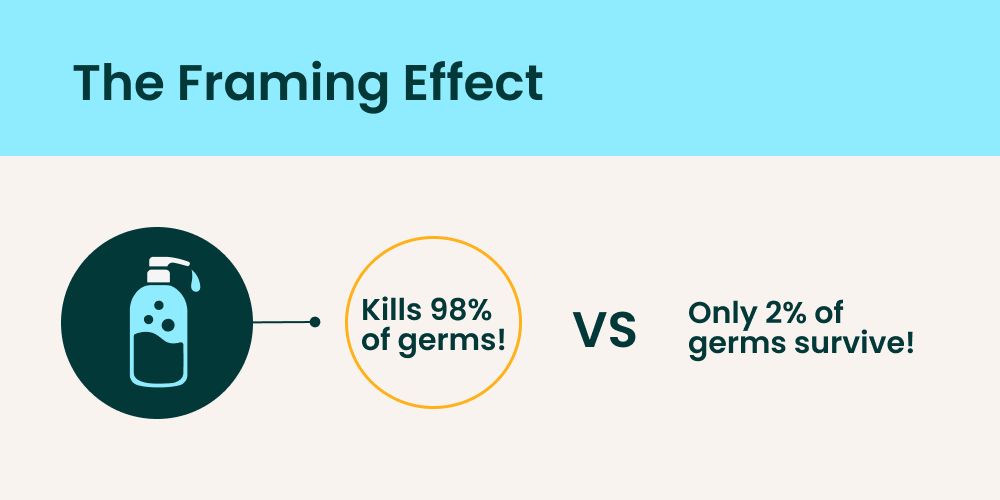
In addition, while marketers do want to address common customer pain points, make sure to discuss them in a way that frames the solution front and center. This is a much more effective marketing strategy than focusing on things that cause customers grief or frustration.
7. The Decoy Effect
Also known as the asymmetrical dominance effect, the decoy effect is when a person changes their decision between two options when a third, less attractive option, the “decoy”, is added.
The decoy must be asymmetrically dominated. This means that it’s clearly entirely inferior to one of the options, known as the target, and partially inferior to the other option, the competitor. The presence of the decoy therefore triggers people to choose the target over the competitor.
Decoy effect in marketing
The decoy effect has a compelling effect on consumers. Most often, it’s used to convince people to buy more than they need. We have all been the victims of the decoy effect without even realizing it. Have you ever been convinced to buy a “meal deal” at a restaurant instead of just the sandwich you wanted because the meal was only slightly more expensive? That’s the decoy effect!
National Geographic tested the decoy effect at a movie theater. They offered movie-goers two different sizes of popcorn: a small for $3 or a large for $7. Nearly every customer chose the small size, claiming that $7 was a bit steep for popcorn.
Then, the sellers added a decoy. In addition to the small for $3 and the large for $7, they offered a medium popcorn for $6.50. With the addition of the decoy, the option of a large for just an extra 50 cents suddenly became more attractive. A higher percentage of people started buying the large because they felt it was a better value.
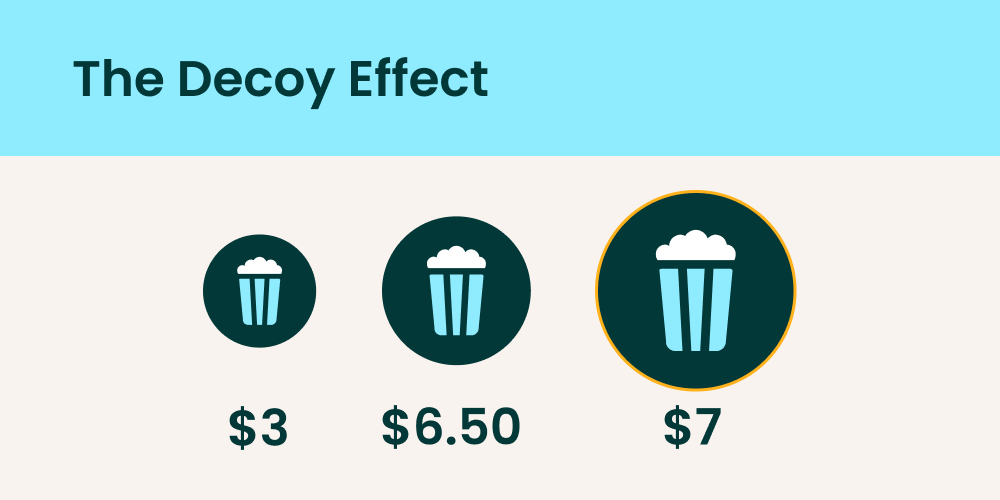
Marketers can use the decoy effect to encourage customers to choose a certain product option. Simply by adding an asymmetrically dominated decoy, you can make the more expensive option look way more appealing.
8. The Mere Exposure Effect
People like things that are familiar to them. Therefore, the more they see something, the more familiar it becomes, and the more they have a tendency to like it. This is known as the mere exposure effect or the familiarity principle.
The mere exposure effect explains why so many people have the tendency to order the same dish over and over again instead of trying something new. It explains why people often go back and watch movies they’ve already seen and enjoyed rather than exploring different options. It reveals why the more you hear a song on the radio, the more it seems to grow on you.
Various studies have shown that people feel more positively about words, images, and faces that they have seen before. This holds true even if they don’t remember that they have seen the stimuli before, because it occurs on a subconscious level.
The mere exposure effect in marketing
According to the mere exposure effect, if you want people to like your brand more, you simply have to make sure they see it more frequently. Naturally, the more familiar your brand becomes, the more consumers will like and trust you.
Therefore, all you have to do to use the mere exposure effect to your benefit is to get your brand out there as much as possible. Make sure potential customers see your logo, brand name, and whatever you’re trying to sell as frequently as you can. So go ahead and boost the frequency of your social media advertising, send out a few more emails, and familiarize people with your brand. They’ll be more likely to feel positively about your brand, and more likely to trust you.
9. Scarcity Principle
Scarcity affects peoples’ perception of value. In other words, people want what they can’t have. This is the scarcity principle, and it goes back to the basic economics of supply and demand. The more rare or difficult to acquire an object or opportunity is, the more valuable it becomes.
This was demonstrated in an interesting study conducted in 1975. The researchers asked participants to rate chocolate chip cookies. One jar of cookies was filled with ten cookies, while another jar was filled with only two cookies. Participants rated the cookies in the jar with only two cookies twice as high as the jar with many cookies. However, all of the cookies were exactly the same.
Since the cookies in the two-cookie jar were seen as scarce, their value went up. It’s clear that scarcity distorts peoples’ opinion of value.
The scarcity principle in marketing
Why do people line up outside of the Nike store the night before a new sneaker launch? How can a brand-name bag sell for so much more than a generic competitor? It all goes back to the scarcity principle.

If you use the scarcity principle in your advertising strategy, you can convince people that the value of your product is quite high. This works best if consumers believe that there used to be a lot of your product, but because demand was so high, there’s not much left anymore.
One of the easiest ways to use scarcity in marketing is to highlight that just a few items are left for purchase. Hotels often use this tactic to convince people to book rooms by displaying that there are “only two left at this price”. For popular brands, launching a limited-supply edition of a product can create the hype needed to increase sales, too.
10. Bandwagon Effect
The bandwagon effect is the term given to peoples’ tendency to think and act the same way as those around them. It can greatly influence decision-making and even cause people to behave in a way that doesn’t line up with their own beliefs.
This effect is frequently seen in politics and sports. Voters often rally around a particular candidate because others in their social sphere seem to support them. In sports, fans may switch allegiance to support a more winning team if other fans are making the same shift.
In the 1950s, Solomon Asch performed a series of experiments on conformity, testing how readily participants answered a question incorrectly in order to go along with the rest of the group. The researchers presented a room full of people with different line segments and asked them to choose the matching segments.
However, unbeknownst to the participants, the other people in the room were part of the experiment. When all of the other people in the room gave an incorrect answer, the participants conformed. Almost 75% of participants gave an incorrect answer at least one time.
There is a famous 1962 episode of the old TV show Candid Camera which tests out this effect, too. In the elevator experiment, the subject is in an elevator. Other people enter the elevator, but each one turns and faces away from the door. Inevitably, once several people enter and face the wrong way, the subject begins to feel uncomfortable and also turns around. Even though the subject knows they’re facing the wrong way, they feel the need to do what everyone else is doing.
The bandwagon effect in marketing

We have all been influenced by the bandwagon effect, whether we realize it or not. Have you ever been browsing products and received a popup letting you know that another customer has made a purchase? That’s the bandwagon effect. Counters displaying the number of items sold is another example of the bandwagon effect in action.
One of the most common and effective ways to utilize the bandwagon effect in your marketing strategy is through customer reviews. For many consumers, seeing that other people just like them have purchased and enjoyed a product is a critical stage in convincing them to buy it. In fact, over 99% of consumers report that they consult reviews at least sometimes when making an online purchase.
The volume of reviews makes a difference too. When a product page includes 1-10 reviews, the conversion rate increases by 52.2%. But when there are 101 or more reviews, the conversion rate increases by over 250%.
Another practical use of the bandwagon effect is to show consumers images of people they trust using your product. Influencer marketing utilizes this psychological principle to convince potential customers to join the crowd and purchase your product.
Highlighting the number of people who have purchased your product or including a real-time customer activity counter on your website can also encourage people to jump on the bandwagon.
Funding for your marketing needs
There are certainly a lot of ways to leverage psychological principles in your marketing campaigns and increase your conversion rate.
But marketing takes capital. If your eCommerce business needs working capital to invest in marketing, 8fig can help. 8fig is a growth partner for eCommerce businesses, designed to maximize their growth through cash flow friendly financing and tools for growth. We fund up to 90% of supply chain costs, including marketing.
It’s easy and fast to get started. Sign up for an 8fig Growth Plan today and see how we can help you grow your business and reach your full potential.
Subscribe to the eCommerce newsletter for
top industry insights
to our blog
Read the latest
from 8fig
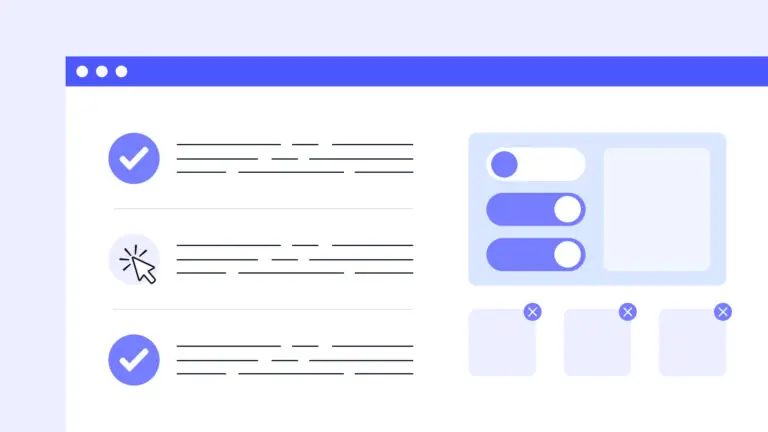
Customization is everywhere – your playlists, your shopping cart, your subscriptions. So why settle for rigid funding? With 8fig, you’re in control. See why flexible financing is the future of eCommerce.
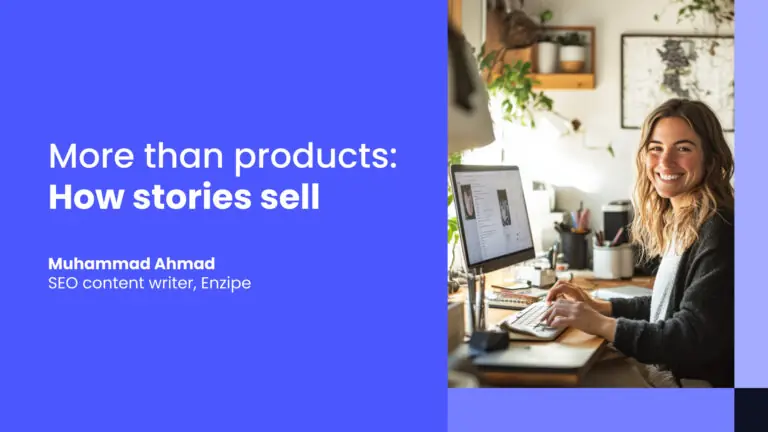
Products don’t sell – stories do. Learn how top brands use storytelling to create emotional connections, build trust, and drive sales. Ready to craft a narrative that converts? Let’s dive in.
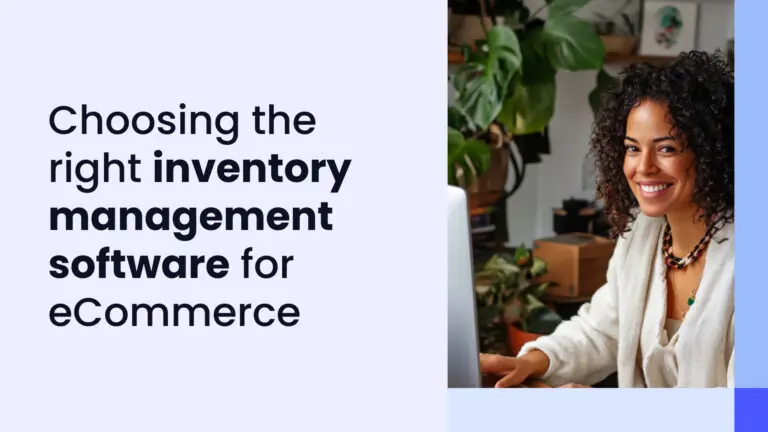
Choosing the right inventory management software is key to avoiding stockouts and maximizing profits. Explore top features and expert tips to make demand-based restocking effortless.
